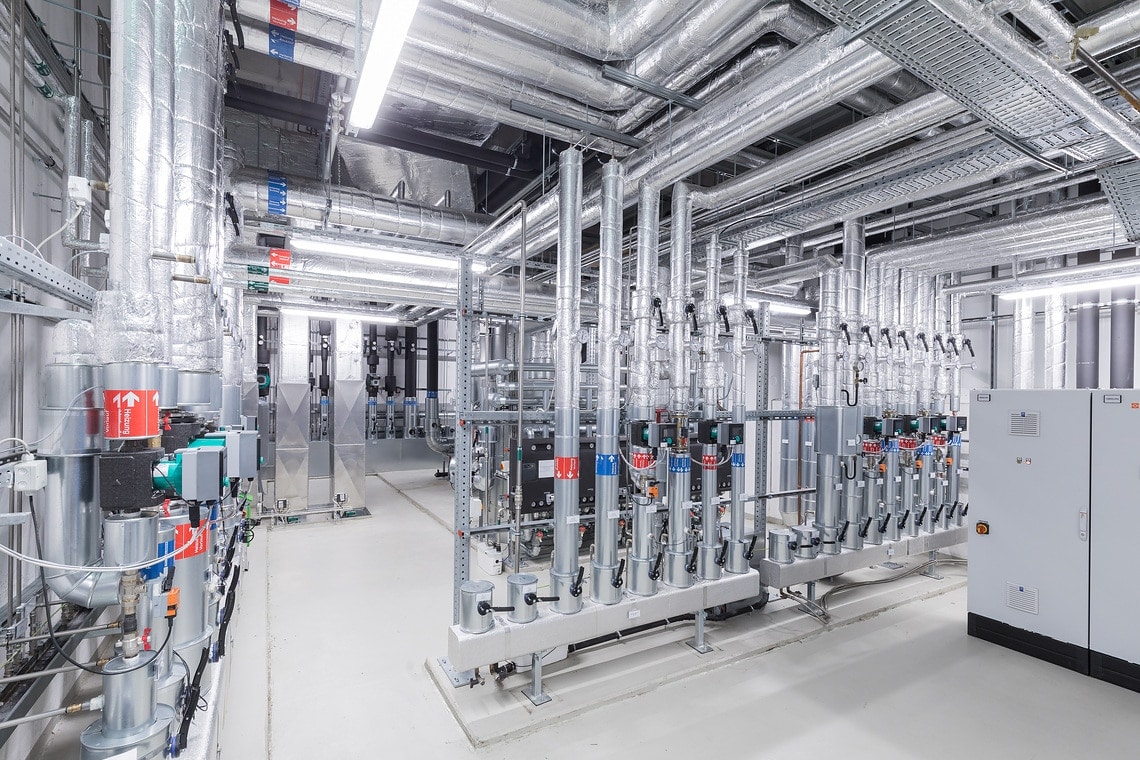09.04.2021
The technology specialist Wilo is creating a whole new work environment in Dortmund over an area of more than 180,000 m2.
At the head office, the Wilopark in the centre of Europe, a "state of the art" workplace for around 2,000 employees from Administration and Production has been created after just five years of construction. Wilo is committed to ergonomic and flexible working, efficiency and sustainability here. The production facility of the future as well as the administrative office building with space for creativity and concentration characterise the work on the new site. The company’s own products are used at the site in the south of the Westphalian metropolis for efficiency-optimised operation.
When Wilo located to Nortkirchenstraße in Dortmund Hörde in the 1960s, it was surrounded by fields and meadows on one side and the monumental blast furnaces of the steel and mining giant Hoesch on the other. Almost 60 years later, the backdrop is completely different: blast furnaces which have long since cooled down and decommissioned gasometers are steely relics of a bygone industrial age. High-tech and digitalisation have literally taken over the site of the former Phoenix-West steelworks, epitomised by the new construction of the Wilo head office, the largest site development project in the company’s history. The Wilopark will span a total area of about 180,000 m², which is the equivalent of 26 football fields, by the time the company celebrates its 150th anniversary in 2022. The completion and occupation of the new Smart Factory, planned and built according to Industry 4.0 standards, and the global headquarters, the Pioneer Cube, designed for creative and cooperative work, represented a big step towards a digital future in 2020, creating the future basis for more efficient production, optimised material flow and smart logistics. The new plant road “Wilopark” connects the site from west to east and opens onto the central square, Focus, where the most important buildings for the site are located. “Designing the Wilopark was a project on a whole new scale at the head office in the Ruhr area. We completely revamped the entire site. In the course of this project, we have merged our sites, which were previously scattered throughout Dortmund, into one efficient administrative and production area”, says Holger Herchenhein, Head of the Wilopark project. “Our very own avenue is also open to pedestrians, cyclists and local transport during the day. Public access via the new Nortkirchenstraße is now located on the northern edge of the site.” The company bid farewell to the existing buildings from the 60s, with the new buildings being constructed and operated with Wilo’s sustainability strategy in mind.
Climate-neutral production in a modern environment
Wilo aims to achieve climate-neutral production at its global sites by 2025. In Dortmund, this goal should already have been achieved: “We produce green energy with the photovoltaic system and meet other needs with green electricity and a combined heat and power plant”, Herchenhein explains.
Heat recovery and intelligent building management systems, as well as integrated energy monitoring and management, are all elements of the sustainability concept. Here, Wilo makes use of advancing digitalisation: sensor technology, communication capabilities as well as data monitoring and evaluation do not just play a central role in the company’s own products. Real-time monitoring of production processes is also used in the factory to make them as energy-efficient as possible and to adjust them if necessary. Electricity, heating and cooling are therefore provided centrally via efficient units and a distribution network, for instance. The bottom line is that these measures reduce energy consumption by up to 40 percent and CO2 emissions by 3,500 tonnes compared with 2015. Rainwater from the outdoor facilities and from over 70,000 square metres of roof surface is collected and held in rainwater storage channels: “The rainwater is collected on green roofs and in underground channels. Part of it is then used as process water, for example for cooling purposes and flushing toilets on the site”, Holger Herchenhein explains further. “As soon as the southern part is completed, some more of the water will be used to water the plants there. Sediments are filtered out of the unused rainwater and these are then returned to a stream and thus the natural water cycle”. The green roof also provides natural insulation for the buildings and improves the Wilopark micro-climate. The primary energy demand can largely be met by the 6,000 square meters of solar panels: around 10 % of the total electricity consumption and 70 % of the base load in summer is produced by the photovoltaic plant. Any additional electricity required is produced at the site by a combined heat and power plant whose waste heat is also used all year round: for heating during the colder months and by means of converting it to cold for cooling in the summer months. Other requirements are bought exclusively as “green energy” from renewable energy sources.
Efficient pump solutions from our own production
A total of 166 Wilo pumps are in operation at the Wilopark: Wilo-Stratos MAXO, Wilo-Stratos GIGA, Wilo-CronoLine IL-E and CronoTwin DL-E as well as Wilo-DrainLift. “We are one of the worldwide leading premium providers of pumps and pump systems – of course we stand by this and believe in what we promise our customers. For this reason, we’ve also decided to use our own products at the new headquarters”, notes Herchenhein. 133 of the pumps are used in the factory and 33 pumps in the Pioneer Cube office complex for heating, ventilation and cooling.
With the Wilo-Stratos MAXO, the company is focusing entirely on smart products. The MAXO is the first pump to feature a self-explanatory user interface – and make installation and operation uniquely simple. The pump also redefines system efficiency: It attains maximum system efficiency through innovative energy-saving functions and new control modes. Maximum compatibility with existing systems is also a matter of course.

A total of 166 pumps are used at the Wilopark